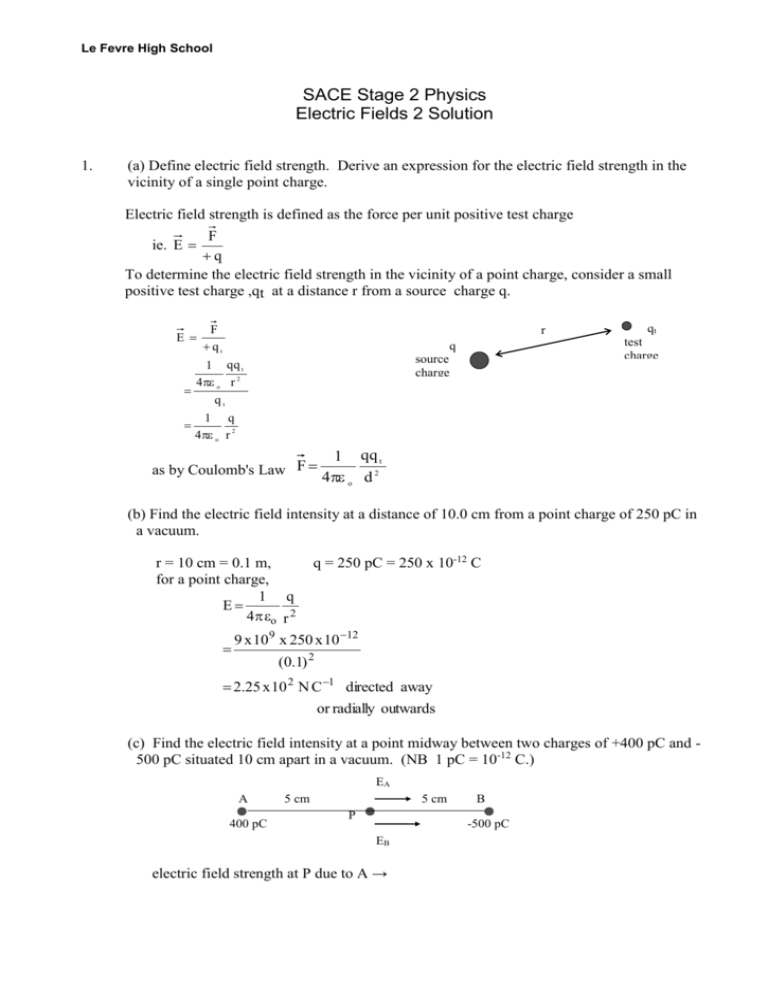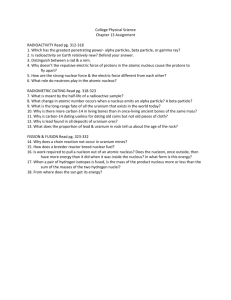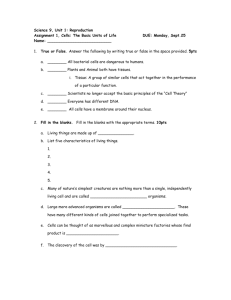Worksheet - Electric Fields 2 Solution
advertisement

Le Fevre High School SACE Stage 2 Physics Electric Fields 2 Solution 1. (a) Define electric field strength. Derive an expression for the electric field strength in the vicinity of a single point charge. Electric field strength is defined as the force per unit positive test charge F q To determine the electric field strength in the vicinity of a point charge, consider a small positive test charge ,qt at a distance r from a source charge q. ie. E E F qt r q source charge 1 qq t 4 o r 2 qt qt test charge 1 q 4 o r 2 as by Coulomb's Law F 1 qq t 4 o d 2 (b) Find the electric field intensity at a distance of 10.0 cm from a point charge of 250 pC in a vacuum. r = 10 cm = 0.1 m, for a point charge, 1 q E 4o r 2 q = 250 pC = 250 x 10-12 C 9 x 10 9 x 250 x 10 12 (0.1) 2 2.25 x 10 2 N C 1 directed away or radially outwards (c) Find the electric field intensity at a point midway between two charges of +400 pC and 500 pC situated 10 cm apart in a vacuum. (NB 1 pC = 10-12 C.) EA A 400 pC 5 cm 5 cm P B -500 pC EB electric field strength at P due to A → Le Fevre High School EA 9 x 10 9 x 400 x 10 12 (0.05) 2 1.44 x 10 3 N C 1 directed to the right E B = 1.8 x 10 3 N C -1 to the right similarly, E total = 3.24 x 10 3 N C -1 to the right 2. What is the electric field intensity at a point 2.4 m from a point charge of 5.7 m C in air? q = 5.7 m C =5.7 x 10-3 C . r = 2.4 m E 1 q (point charge) 4o r 2 9 x 10 9 x 5.7 x 10 3 (2.4) 2 8.9 x 10 6 N C 1 directed away 3. A If in the fig below A, B and C are -12 each positive charges of 8.0 x 10 Coulomb, (a) Find the electric field intensity at a point C 2.0 cm from A and 2.0 cm from B. Electric field strength at C due to A 1 q E 4o r 2 EA 23 cm B 1 cm 2 cm 2 cm C 30o 30o 9 x 10 9 x 8 x 10 12 (0.02) 2 180 N C 1 directed away from A E B = 180 N C -1 directed away from B E total = E A + E B E total (b) (vector addition ) 120o Hence, find the force acting on the charge C. 180 N C-1 EA EB = 180 N C -1 vertically down F Eq = 180 x 8 x 10-12 = 1.44 x 10-9 N vertically down. 4. 180 N C-1 60o EA Etotal 60o 60o EB Find the point between charges of +8.00 C and +6.00 C, which are situated 4.00 m apart in a vacuum, where the electric field strength is zero. Le Fevre High School A r cm (4 - r) cm B let P be the point where there is no Pnet field at P → +8 C +6 C EA EA = EB EB 1 q EA but 4o r 2 9 x 10 9 x 8 x 10 6 r2 9 x 10 9 x 6 x 10 6 EB = E A (4 r ) 2 Hence, 9 x 10 9 x 8 x 10 6 r2 4 r 2 9 x 10 9 x 6 x 10 6 (4 r ) 2 3 (4 r ) 2 Hence, 2 3 r 4r 2(4 r ) 1.732 r 8 2r 1.732 r 3.732 r 8 r 2.145 m Hence answer is 2.1 m from 8 C charge . (or 1.9 m from the 6 C charge) 5. A Uranium nucleus can be regarded as a spherical object of radius 2 x 10-14m containing 92 protons as well as neutrons. The electric field around the nucleus is the same as a point charge concentrated at the centre of the nucleus. (a) Estimate the electric field strength at the surface of the nucleus E 1 q assuming point charge 4o r 2 9 x 10 9 x 92 x 1.6 x 10 19 (2 x 10 14 ) 2 3.31 x 10 20 N C 1 radially outwards (b) If an alpha particle (this is an helium nucleus containing two protons) is close to the uranium nucleus estimate the size of the electric force acting on it. For alpha particle q = 2 x 1.6 x 10 -19 C (remember the charge on a proton is the same size as that on electron) assume close distance = 10 x radius Le Fevre High School 1 th as large. → F = Eq 100 1 = 3.31 x 10 20 x x 2 x 1.6 x 10 -19 100 F = 1.06 N radially outwards. This is a huge force on such a small particle. Hence estimate the initial acceleration of the helium nucleus away from the uranium nucleus. 1.06 F a= = m 4 x 1.67 x 10 27 E will be (c) = 1.58 x 10 29 ms -2 6 huge! (a) How are lines used to represent the electric field strength in an electric field? The spacing of the lines is used to represent the magnitude of the field strength and the direction of the lines is used to represent the direction of the field. The larger the spacing the weaker is the field. (b) Draw diagrams and sketch on each the electric field lines that correspond to each situation. (i) Single Point Positive Charge (ii) Single Point Negative Charge +q -q (iii) Two equal magnitude positive charges (iv) Two equal magnitude negative charges +q +q -q (v) Two equal magnitude but opposite sign charges +q -q -q Le Fevre High School (vi) Oppositely charged parallel plates (vii) A positively charged hollow sphere + + + + + + + + + + + - - - - - - - - - - (viii) Negatively charged hollow sphere - - - - - - - - - - - (ix) Equally charge co-axial cylinders (similar to parallel plate). Application is to a coaxial cable - - + - - + + + + + + - - - + - (x) Point charge and a parallel plate. Similar to the electrode system gun. + - + + + + of an electron








